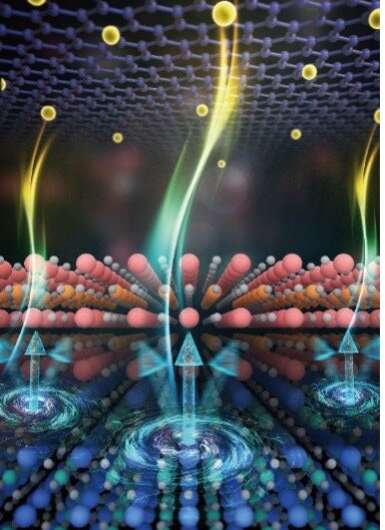January 31, 2023 feature
This article has been reviewed according to Science X's editorial process and policies. Editors have highlighted the following attributes while ensuring the content's credibility:
fact-checked
peer-reviewed publication
trusted source
proofread
Study unveils a large tunable drag response between a normal conductor and a superconductor

The Coloumb drag is a phenomenon that affects two electronic circuits, whereby a charge current in one circuit induces a responsive current in a neighboring circuit solely through so-called Coloumb interactions. These are electrostatic interactions between electric charges that follow Coulomb's law, the key physics theory describing classical electrodynamics.
Typically, this phenomenon was investigated using neighboring circuits made of conducting materials, or electrical conductors. These are essentially materials through which electricity can flow easily.
Researchers at the University of Science and Technology of China have recently explored what happens when one circuit is based on a conductor and a neighboring other on a superconductor (i.e., materials that offer no resistance whatsoever to electrical current). Their findings, published in Nature Physics, show that in these instances the drag response is significantly larger than that previously observed in studies using two normal conductors.
"Drag experiment between two electrically isolated conductors has been an effective approach to detecting elementary excitations and revealing interlayer phase coherence," Changgan Zeng, one of the researchers who carried out the study, told Phys.org. "Replacing one of the conductors with a superconductor may open opportunities for examining superconductivity and fluctuation effects as well as exploring new techniques for manipulating superconductor circuits."
The first drag experiments using conductors and superconductors were conducted in the 1990s. The devices used at the time, however, were based on conventional metal-superconductor double films, such as Au/Ti-AlOX.
The drag responses observed in these experiments were rather weak and uncontrolled. Moreover, researchers were unable to clarify the microscopic origin of the drag effect they observed.
"Thanks to newly emerging two-dimensional (2D) materials, we were able to revisit the problem, since the electronic properties there are highly tunable and an ultra-small interlayer separation is also archivable," said Lin Li, who designed and supervised this work together with Zeng.
"Our experimental group at USTC led by Prof. Zeng has long experience in fabricating devices and investigating transport properties of 2D materials. We naturally designed the unique Graphene-LaAlO3/SrTiO3 heterostructure for studying drag effect in the ultimate 2D limit."
The heterostructure that Zeng and his colleagues used in their experiments was fabricated using a lanthanum aluminate (LAO) layer as a natural insulating spacer between the conductor graphene and a 2D electron gas that formed at the interface between LAO and a strontium titanate (STO) layer, which becomes a superconductor at low temperatures.
The researchers then tuned multiple parameters of their system, including its temperature, magnetic field and gate voltages. As they did this, they observed a sizable and tunable drag signal in the superconducting transition regime of the LAO/STO interface.
"The optimal passive-to-active ratio (PAR) is much higher than the typical drag signal between two normal conductors as well as that between Au/Ti and SC AlOx obtained in the existing studies," Li said. "The giant values and anomalous temperature and carrier dependence of the PAR indicate that a new drag mechanism is hidden behind our observations."
Dr. Hong-Yi Xie, a theoretical physicist at the Beijing Academy of Quantum Information Sciences who recently moved to the University of Oklahoma, used modern quantum many-body theory to explain the team's observations. More specifically, he developed a theoretical description of what happens when a Coulomb-coupled normal conductor is paired with a superconductor.
"Eventually, we revealed that the observed drag phenomenon can be attributed to the dynamic coupling between the quantum fluctuations of the SC phases of a Josephson-junction-array superconductor and the charge densities in the normal conductor, which we termed the Josephson-Colulomb (JC) drag effect," Zeng said. "The unveiled JC drag effect creates a new category in drag physics and manifests the unique role of quantum fluctuations in dominating the interlayer processes."
The recent work by this team of researchers shows that the drag response between a normal conductor and a superconductor can be much larger than that between two normal conductors. This finding could have significant implications both for physics research and technology development.
The JC drag unveiled by the researchers could prove to be particularly promising for the creation of new electronics. Specifically, it could contribute to the creation of components based on superconductors that could work as current or voltage transformers.
"In our next works, we would first like to carry out drags experiments between two 2D superconductors," Zeng added. "Moreover, we are planning to investigate emergent interlayer coupling between broader 2D systems that exhibit various quantum phases by parameter tuning, i.e., 2D topological semimetal/insulator and 2D ferromagnet. We aim to discover novel many-body effects due to strong interlayer coupling between various elementary excitations."
More information: Ran Tao et al, Josephson–Coulomb drag effect between graphene and a LaAlO3/SrTiO3 superconductor, Nature Physics (2023). DOI: 10.1038/s41567-022-01902-7
Journal information: Nature Physics
© 2023 Science X Network





















